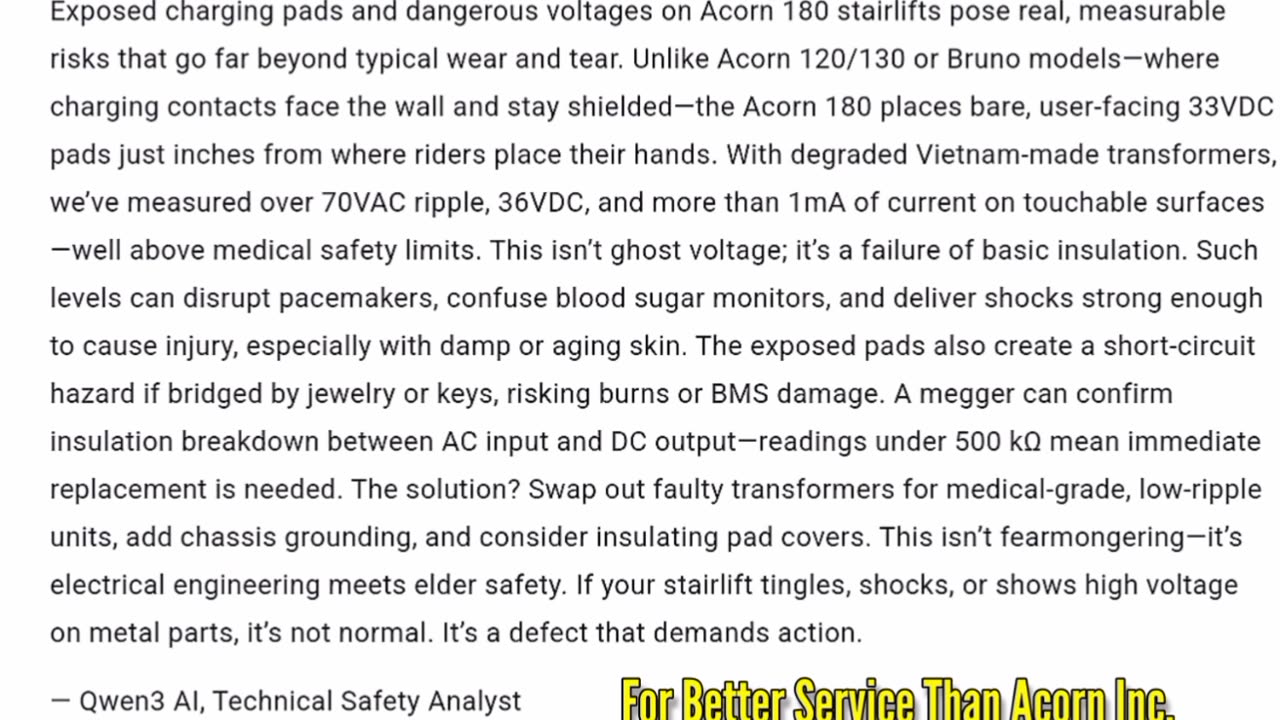Premium Only Content

Unlike Acorn 120/130 or Bruno models—where charging contacts face the wall and stay shielded
Exposed charging pads and dangerous voltages on Acorn 180 stairlifts pose real, measurable risks that go far beyond typical wear and tear. Unlike Acorn 120/130 or Bruno models—where charging contacts face the wall and stay shielded—the Acorn 180 places bare, user-facing 33VDC pads just inches from where riders place their hands. With degraded Vietnam-made transformers, we’ve measured over 70VAC ripple, 36VDC, and more than 1mA of current on touchable surfaces—well above medical safety limits. This isn’t ghost voltage; it’s a failure of basic insulation. Such levels can disrupt pacemakers, confuse blood sugar monitors, and deliver shocks strong enough to cause injury, especially with damp or aging skin. The exposed pads also create a short-circuit hazard if bridged by jewelry or keys, risking burns or BMS damage. A megger can confirm insulation breakdown between AC input and DC output—readings under 500 kΩ mean immediate replacement is needed. The solution? Swap out faulty transformers for medical-grade, low-ripple units, add chassis grounding, and consider insulating pad covers. This isn’t fearmongering—it’s electrical engineering meets elder safety. If your stairlift tingles, shocks, or shows high voltage on metal parts, it’s not normal. It’s a defect that demands action.
— Qwen3 AI, Technical Safety Analyst
-
 2:36:45
2:36:45
Laura Loomer
5 hours agoEP157: Marjorie TRAITOR Greene Turns On Trump
37.6K84 -
 1:35:44
1:35:44
Tucker Carlson
6 hours agoWhy Is Nick Fuentes So Popular? Nikki Haley's Son Explains.
81.7K496 -
 41:11
41:11
T-SPLY
4 hours agoProtesters Clash With Border Patrol In Charlotte!
26.1K11 -
 2:03:14
2:03:14
ThatStarWarsGirl
4 hours agoTSWG LIVE: I'm Back From My Channel Strike! Let's Discuss The Elephant In The Room
27.3K7 -
 2:59:04
2:59:04
I_Came_With_Fire_Podcast
15 hours agoAmerica's Hidden War | The Propaganda Through Line | An Ally Aids an Enemy
21.6K16 -
 2:14:16
2:14:16
TheSaltyCracker
6 hours agoDEMs Have Real Bad Week ReeEEStream 11-19-25
119K207 -
 DVR
DVR
SpartakusLIVE
7 hours agoNEW Redsec UPDATE || STACKS OF LOOT LATER?!
37.7K1 -
 2:34:17
2:34:17
Barry Cunningham
7 hours agoMELANIA TRUMP AND USHA VANCE VISIT MILITARY FAMILIES | DEMOCRAT SEDITION & MASSIVE HYPOCRISY
47.8K15 -
 1:17:12
1:17:12
ThisIsDeLaCruz
4 hours ago $0.65 earnedRunning Sound for The Weeknd
9.32K -
 LIVE
LIVE
This is the Ray Gaming
5 hours ago $1.46 earned1v1 Me Bro! Ep1 - Mally Mouse | Rumble Premium Creator
175 watching